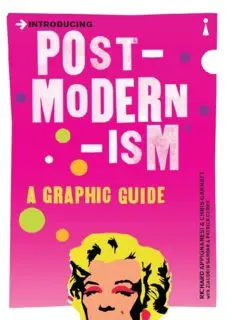Table Of ContentPublished by Icon Books Ltd, Omnibus Business Centre, 39–41 North Road, London N7 9DP
email: [email protected]
www.introducingbooks.com
ISBN: 978-184831-760-4
Text and illustrations copyright © 2013 Icon Books Ltd The author and artist have asserted their moral
rights.
Originating editor: Richard Appignanesi No part of this book may be reproduced in any form, or by any
means, without prior permission in writing from the publisher.
Contents
Cover
Title Page
Copyright
First, let’s consider the WORD…
PART ONE: THE GENEALOGY OF POSTMODERN ART
What’s Modern? The Shock of the Old
Dialectical Antagonism
What’s MODERNISM?
Picasso’s Big Bang
The Crisis of Representation
Cézanne: the View Contains the Viewer
The “Science” of Cubism
The End of Original Art?
Modern is Postmodern
The Sublime
Genealogy of a Modernist tree
Machine-Aesthetic Optimism
Constructivism
Stalinist Totalitarianism
The Tragic Failure of Abstract Expressionism
DADA!
Marcel Duchamp and the Readymades
The Aura of the Artist
The Event
Installations
The Supreme Master of Po Mo Art?
Was Duchamp to Blame?
ENDGAME
We’re keeping pace with modernity…
Expiry Date
False Postmodernisms
Eclectic Postmodernism
A “Real” Postmodernism?
What you see is what you get…
Legitimation
The Simulacrum
PART TWO: THE GENEALOGY OF POSTMODERN THEORY
Structuralism
Meanings and Signs
Signification
The Binary Model
Figures of Speech: Metaphor and Metonymy
Semiology
Structural Anthropology
Brief Critique of Structuralism
Poststructuralism
The Death of the Author
Writing: Degree Zero
…Poststructuralist Blues… No Exit from Language
Deconstruction
J’ACCUSE!
“Différance”
The Accuser Accused…
The Structures of Power/Knowledge
Art and Power/Knowledge
Eugenics: measuring the excluded inferior
Some possible conclusions
What is Power?
The Fiction of the Self
The Imaginary or “Mirror Phase”
The Symbolic Order
Not entirely silenced…
No Place in History
What is Postmodern Feminism?
The end of the story…
Scientific Legitimation
Knowledge is a post-industrial force of production
Theories of Everything
The Anthropic Principle
A Retraction…
Genetics
PART THREE: THE GENEALOGY OF POSTMODERN HISTORY
Po Mo Vernacular
Computerizing Difference
Simulated Reality and Disneyland
Welcome to the Holocaust Theme Park
The Installation of Memory Loss
Hypermodernism: the Memory Loss of Reality
Hyperreal Finance
Welcome to Cyberia!
A Walk on the Wild Side
The War as NOT seen on TV
The first Cyberwar?
Only (re)Produce
CYBERIAN STREETSCENES
“I wannabe a wigger”
Karaoke…
…and Serial Killings
X-rated Cybersex Games
Cyborgs and Schwarzenegger
Madonna, Cybergirl
Zapping or Zero-Consciousness
Endlessly Contemporary Amnesia
Zapped-out Hypermodernism
Icons of the Respectable Right
The Satanic Verses and Postmodern Panic
Third World Postmodernism
The End of History
Teleology
Eschatology and the last Men
Virtual Reality
A Post-Marxist Repentance
Endgame…
Return of the “Grand Narrative” Philosophers?
Bug-eyed into the 21st Century
Did you wish for “9/11” too?
The Fourth World War
War on Terrorism… as seen on TV
The Clone in the Scrap-yard
Virus or Blowback?
The New Bolsheviks
The Liberal Consensus
The Last Grand Narrative
The Future is Tomorrow’s Past
The Art of Terrorism
What is Postmodern Now?
Cold Comfort in Science
The End of Culture
Beyond our Conscious Perception
Neither God, the Cosmos nor Consciousness
Further Reading
Acknowledgements
Biographies
Index
Charles Jencks, an authority on postomodern architecture and art, provides a
useful scanning of the term postmodern. But what does it mean in practice?
Does “postmodern” accurately aum up the story of what we are present? Or is it
just a fashionable term that leaves us unenlightened about our true historical
condition?
First, let’s consider the WORD…
What do you mean postmodern? The confusion is advertised by the “post”
prefixed to “modern”. Postmodernism identifies itself by something it isn’t. It
isn’t modern anymore. But in what sense exactly is it post…
-as a result of modernism?
-the aftermath of modernism?
-the afterbirth of modernism?
-the development of modernism?
-the denial of modernism?
-the rejection of modernism?
Postmodern has been used in a mix-and-match of some or all of these meanings.
Postmodernism is a confusion of meanings stemming from two riddles…
-it resists and obscures the sense of modernism -it implies a complete knowledge
of the modern which has been surpassed by a new age.
A new age? An age, any age, is defined by the evidence of historic changes in
the way we see, think and produce. We can identify these changes as belonging
to the spheres of art, theory and economic history, and explore them for a
practical definition of postmodernism.
Let’s begin with art by tracing the genealogy of postmodern art.
PART ONE: THE GENEALOGY OF
POSTMODERN ART
We could begin by visiting an installation by the Conceptual artist Daniel Buren
(b.1939), entitled On two levels with two colours (1976), which features a
vertically striped band at the floor levels of two adjoining gallery rooms, one at a
step up from the other. Empty rooms, nothing else…
HOW DID WE GET TO THIS? DO WE WANT TO STAY? HOW DO WE LEAVE, IF WE WANT TO?
Buren’s installation is not necessarily a representative example of art in the
postmodern age. But it is a good place to start from, in the sense of where
modernism itself has arrived at through a persistent history of innovation.

